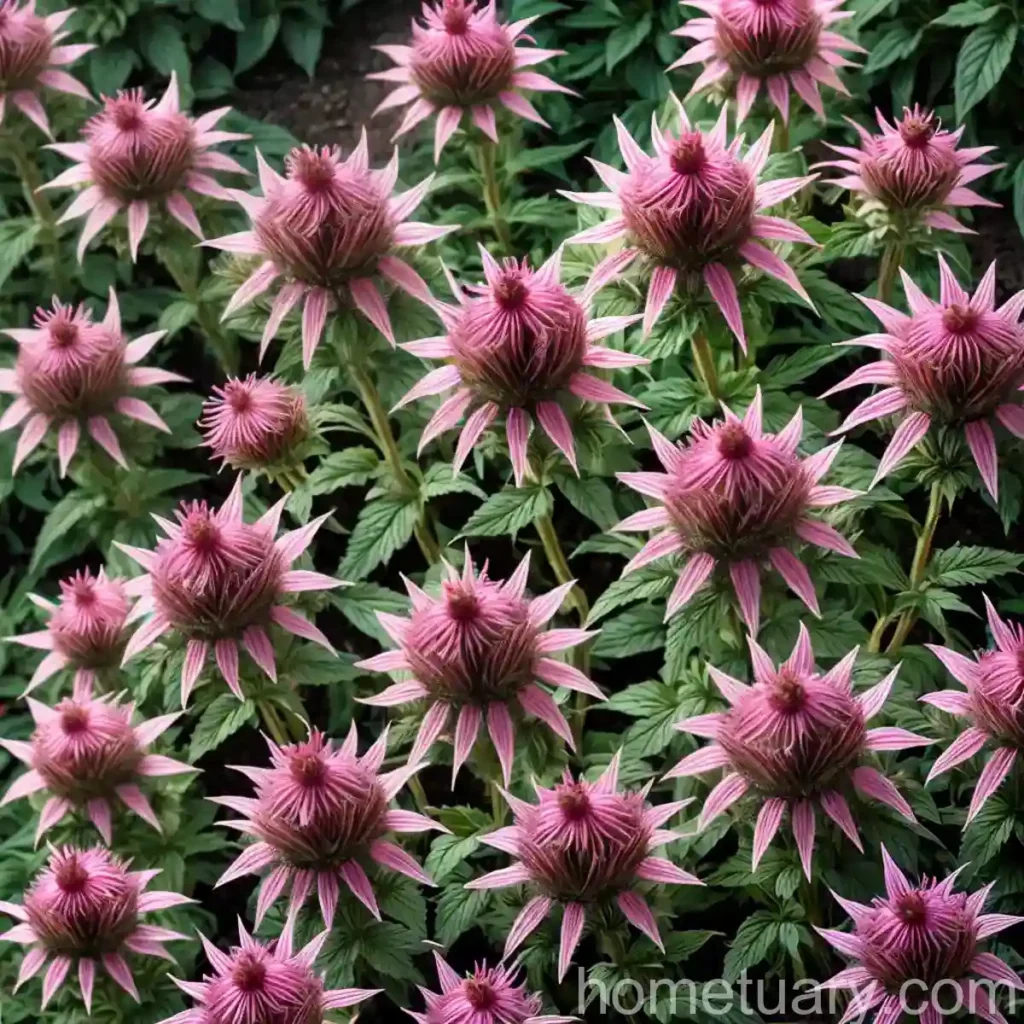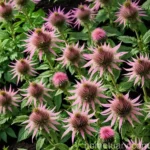Plant Profile: Bee Balm (Monarda didyma ‘Pink Frosting’)

Bee balm, scientifically known as Monarda didyma ‘Pink Frosting’, is a beautiful and versatile perennial plant that is popular among gardeners for its vibrant flowers and aromatic foliage. The plant belongs to the mint family, Lamiaceae, and is native to North America. In this comprehensive guide, we will explore the key characteristics, cultivation, uses, and maintenance of bee balm, providing valuable insights for both novice and experienced gardeners.
Key Takeaways – Bee Balm (Monarda didyma ‘Pink Frosting’)
Before delving into the intricate details of bee balm, let’s highlight the key takeaways of this plant:
- Scientific Name: Monarda didyma ‘Pink Frosting’
- Common Name: Bee Balm
- Variety: ‘Pink Frosting’
- Family: Lamiaceae (Mint family)
- Type: Herbaceous perennial
- Flower Color: Pink
- Foliage: Fragrant, green leaves
- Sunlight: Full sun to partial shade
- Soil Type: Moist, well-draining soil
- Height: 2-4 feet
- Spread: 2-3 feet
- USDA Hardiness Zones: 4-9
- Attracts: Pollinators, such as bees, butterflies, and hummingbirds
Now, let’s delve deeper into various aspects of bee balm, including its culture, uses, cultivation requirements, common diseases, and more.
Culture
Water
Bee balm thrives in consistently moist soil, making it essential to provide regular watering, especially during dry spells or periods of drought. However, it is crucial to maintain a balanced approach, ensuring that the soil is well-draining to prevent waterlogged conditions that can lead to root rot. When watering, aim to keep the soil evenly moist but not waterlogged.
Sunlight
Ideally, bee balm should be planted in an area that receives full sun to partial shade. While it can tolerate partial shade, the plant tends to produce more prolific blooms when exposed to ample sunlight. Therefore, choosing a location with at least 6 hours of direct sunlight is optimal for the healthy growth and flowering of bee balm.
Fertilizer
When it comes to fertilization, bee balm generally does not require excessive feeding. However, to promote healthy growth and vibrant blooms, you can apply a balanced, slow-release fertilizer in early spring. Additionally, incorporating organic matter into the soil during planting can provide a nutrient boost and support the plant’s overall vigor.
Soil
The ideal soil for bee balm is rich, moist, and well-draining. It thrives in a slightly acidic to neutral pH range, typically between 6.0 and 7.0. Incorporating organic matter, such as compost or well-rotted manure, into the soil can improve its structure and fertility, creating an optimal growing environment for bee balm.
Pruning
Pruning bee balm is essential for maintaining its shape, preventing overcrowding, and prolonging flowering. Deadheading, which involves removing spent flowers, can encourage the plant to produce additional blooms and prevent self-seeding. Moreover, cutting back the stems in early summer can promote bushier growth and reduce the risk of powdery mildew, a common issue for bee balm.
Propagation
Bee balm can be propagated through division, cuttings, or seeds. Division is often the preferred method, as it allows for the maintenance of the plant’s desired characteristics. Dividing bee balm every 3-4 years not only helps rejuvenate the plant but also prevents overcrowding, promoting better air circulation and reduced disease incidence.
Container Popularity
While bee balm is commonly grown in garden beds and borders, it is also well-suited for container cultivation. The vibrant blooms and aromatic foliage make it an attractive addition to container gardens, providing versatility in terms of placement and arrangement. When growing bee balm in containers, select a pot with adequate drainage holes and ensure regular watering to prevent the soil from drying out.
Uses
Garden Ornament
Bee balm is widely cherished for its ornamental value, as it adds a pop of color and texture to garden landscapes. Whether planted in mixed borders, cottage gardens, or pollinator-friendly landscapes, bee balm’s vibrant flowers and aromatic foliage make it a standout feature, attracting pollinators and adding visual interest.
Pollinator Magnet
The nectar-rich flowers of bee balm are highly attractive to pollinators, including bees, butterflies, and hummingbirds. As a result, it is frequently incorporated into pollinator gardens and wildlife-friendly landscapes, serving as a vital food source for these beneficial insects and contributing to overall biodiversity.
Culinary Herb
In addition to its ornamental appeal, bee balm has culinary uses, particularly for its aromatic leaves that emit a minty, citrus-like scent. The leaves can be infused in teas, used as a flavorful addition to salads, or incorporated into various culinary creations, providing a unique and refreshing flavor profile.
Medicinal Herb
Historically, bee balm has been valued for its medicinal properties, with indigenous communities utilizing its leaves and flowers for various therapeutic purposes. It is believed to possess antimicrobial, antiseptic, and anti-inflammatory properties, leading to its use in herbal remedies and natural healthcare practices.
Aromatic Foliage
Bee balm’s aromatic foliage adds an extra dimension to its appeal, releasing a pleasant fragrance when brushed against or crushed. This feature makes bee balm a popular choice for scent gardens, where the fragrance of the plants contributes to a sensory-rich experience.
Common Diseases and Pests
Disease Diagnosis
One of the most prevalent diseases affecting bee balm is powdery mildew, a fungal infection that appears as a powdery white coating on the leaves. Proper air circulation, adequate spacing between plants, and mildew-resistant cultivars can help mitigate this issue. Additionally, maintaining an optimal watering regimen by avoiding overhead irrigation and promoting well-draining soil can reduce the risk of powdery mildew.
Common Pests
While bee balm is relatively resistant to many pests, it may occasionally encounter issues with spider mites, aphids, and thrips. These pests can cause damage to the foliage by sucking plant juices or creating unsightly webbing. Regular inspection of the plants and the application of insecticidal soaps or horticultural oils can help manage pest populations without causing harm to beneficial insects.
Botanist’s Tips
Optimizing Pollinator Attraction
To maximize the attractiveness of bee balm to pollinators, consider planting it alongside other nectar-rich flowering plants. Creating clusters or drifts of bee balm in the garden can enhance its visibility and appeal to a diverse array of pollinators, contributing to a thriving and dynamic ecosystem within the garden.
Sustainable Harvesting
When collecting bee balm leaves or flowers for culinary or medicinal purposes, practice sustainable harvesting techniques to ensure the continued health and vigor of the plant. It is advisable to harvest selectively, leaving ample foliage for the plant’s growth and ensuring that the overall integrity of the plant is maintained.
Companion Planting
Pairing bee balm with compatible companion plants can offer mutual benefits, such as pest control, enhanced growth, and visual harmony. Consider interplanting bee balm with species that share similar cultural requirements and complementary characteristics, creating a well-balanced and harmonious garden ecosystem.
Fun Facts
- Bee balm derives its common name from the attraction it holds for bees, due to its abundant nectar production and bee-friendly flowers.
- The aromatic leaves of bee balm can be used to make an herbal tea known as “Oswego tea,” which has a refreshing citrus-mint flavor.
- Indigenous American tribes historically used bee balm for various purposes, including medicinal applications, culinary uses, and ceremonial practices, showcasing the plant’s cultural significance.
Links to External Resources
For further information and resources on bee balm (Monarda didyma ‘Pink Frosting’), refer to the following sources:
- The Old Farmer’s Almanac: Bee Balm
- Monarda didyma ‘Pink Frosting’ – Missouri Botanical Garden
- Royal Horticultural Society: Monarda didyma ‘Pink Frosting’
- University of Maryland Extension: Growing Monarda (Bee Balm)
- North Carolina State University: Bee Balm and Monarda Species
In conclusion, bee balm (Monarda didyma ‘Pink Frosting’) stands out as a versatile and valuable addition to any garden, offering not only striking ornamental appeal but also practical uses in culinary and medicinal applications. With its resilience, attractiveness to pollinators, and cultural significance, bee balm continues to captivate and enrich garden landscapes while contributing to biodiversity and sustainability.
References
Please note that the information provided in this blog post is based on the knowledge and expertise of the author, derived from various reputable sources and personal experience. When implementing any cultivation or plant care practices, it is advisable to consult local gardening resources and experts for region-specific recommendations and guidance.















